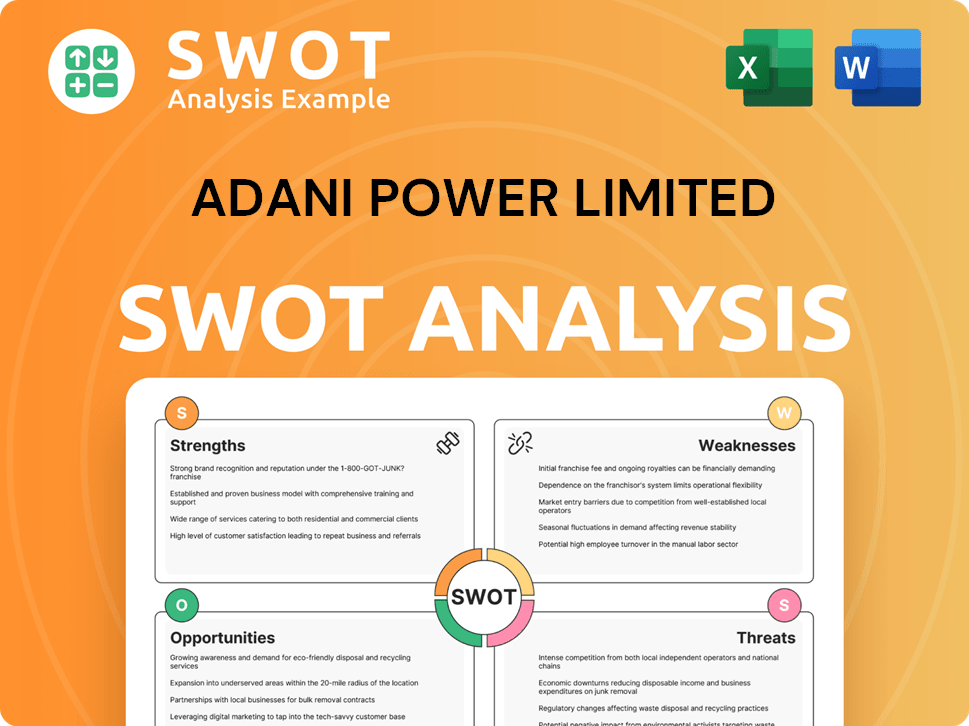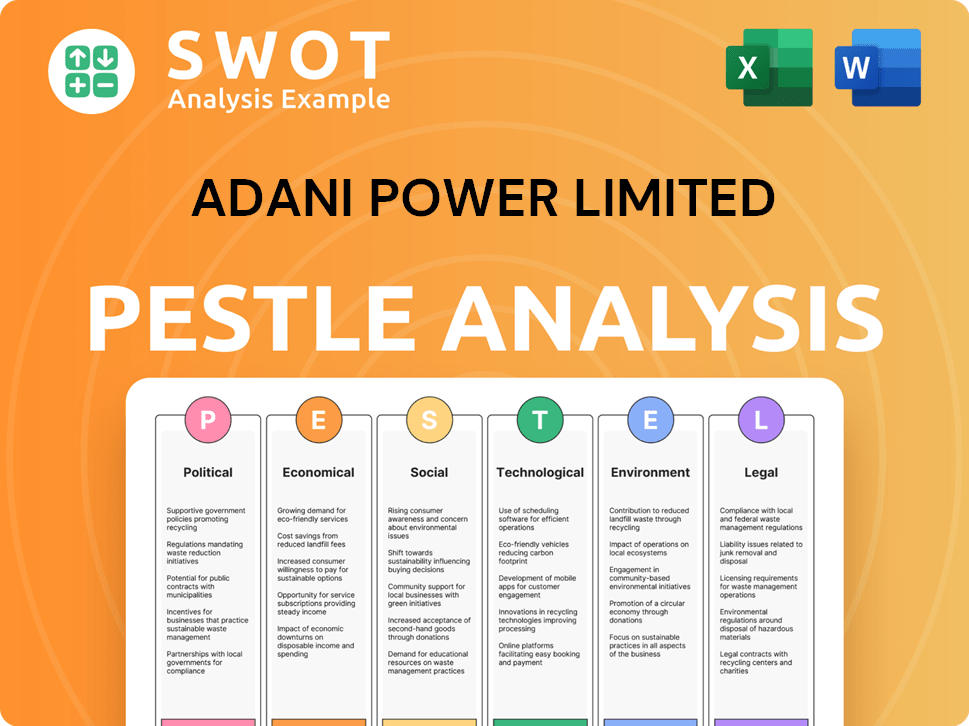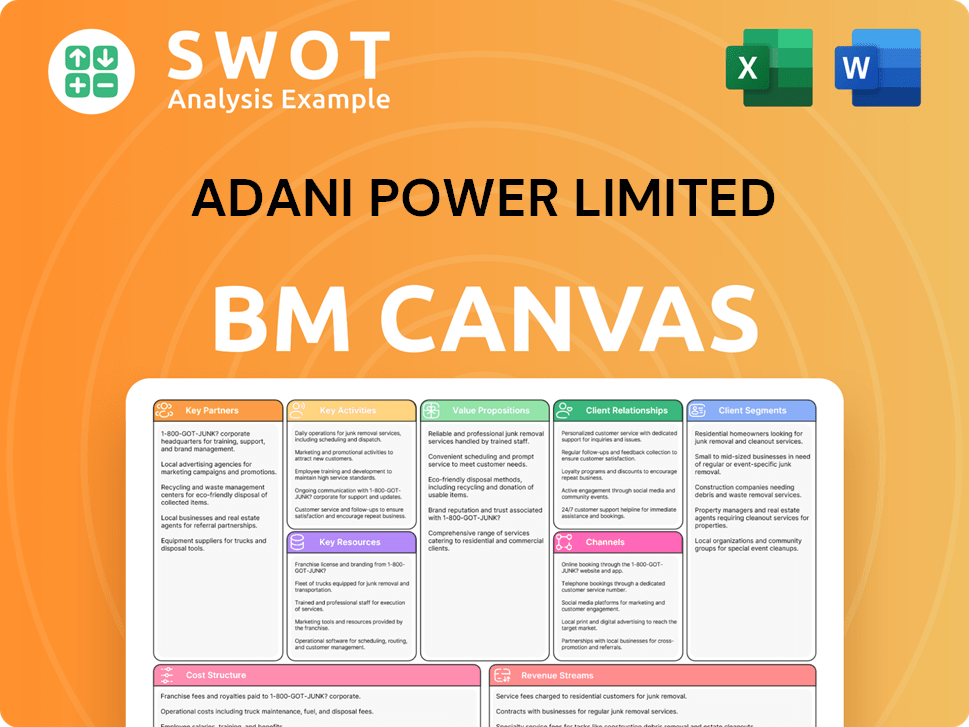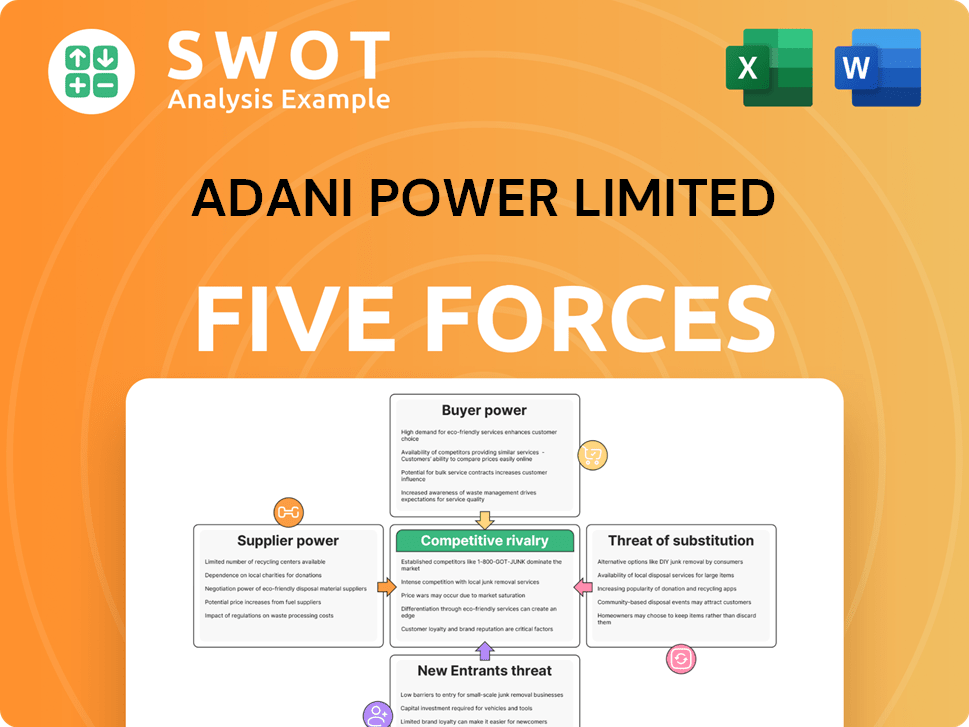Adani Power Limited Bundle
How Does Adani Power Navigate India's Energy Landscape?
Adani Power Limited, a key player within the Adani Group, is India's largest private thermal power producer, significantly impacting the nation's energy sector. With a consolidated revenue of ₹14,237.40 crore in the March 2025 quarter, the company demonstrates its robust operational capabilities and strategic importance. Its substantial operational capacity of 17.5 GW in FY25 highlights its dominance in the power generation market.

Understanding Adani Power Limited SWOT Analysis is crucial for anyone looking to understand the complexities of the energy sector. Adani Power's operations, primarily centered around thermal power plants using coal, are integral to meeting India's base load power demand. This analysis will explore the company's business model, revenue generation, and strategic positioning within the dynamic energy market, providing valuable insights for investors and industry observers alike. The company's recent financial performance and future plans make it a compelling subject for in-depth investigation.
What Are the Key Operations Driving Adani Power Limited’s Success?
Adani Power Limited's core operations focus on generating, transmitting, and distributing electricity, primarily using its network of thermal power plants across India. As of September 30, 2024, the company's operational capacity was at 17.55 GW, making it the largest private power producer in the country. This extensive infrastructure is key to meeting India's increasing electricity needs.
The value proposition of Adani Power lies in its ability to supply reliable and cost-effective base load power. This is crucial for supporting India's rapidly growing electricity demand. The company serves various customer segments, including state distribution utilities, through long-term and medium-term power purchase agreements (PPAs). Approximately 87% of its current operational capacity is tied up in such agreements as of December 31, 2024, ensuring strong revenue visibility and stability.
Adani Power's operational processes include efficient fuel sourcing, mainly coal, with about 91% of its domestic coal needs secured through long-term or medium-term fuel supply agreements as of December 31, 2024. The company strategically locates its plants near coal mines, which reduces fuel costs. The company also leverages its robust logistics and distribution networks, benefiting from its integration within the Adani Group, which has strong interests across the energy value chain.
Adani Power's core capabilities translate into assured power supply for its customers. The company's focus on operational excellence and strategic asset acquisitions results in competitive tariffs. The company maintains high plant availability factors (above 90%) and has improved its plant load factor (PLF), reaching 71% in Q4 FY25 from 64.7% in Q4 FY24.
What sets Adani Power's operations apart is its combination of scale, operational efficiency, and strategic asset acquisitions. The company's aggressive capital expenditure plans aim to increase operational capacity to 30 GW by 2030. This expansion, combined with its operational excellence, positions Adani Power to capitalize on India's growing power demand. You can find more details in the Competitors Landscape of Adani Power Limited.
- Strategic location of plants near coal mines, reducing fuel costs.
- High plant availability factors, ensuring consistent power supply.
- Strong revenue visibility through long-term power purchase agreements.
- Integration with the Adani Group, providing logistics and supply chain advantages.
Adani Power Limited SWOT Analysis
- Complete SWOT Breakdown
- Fully Customizable
- Editable in Excel & Word
- Professional Formatting
- Investor-Ready Format

How Does Adani Power Limited Make Money?
Adani Power Limited, a key player in the energy sector, primarily generates revenue through the sale of electricity. Its operations are heavily focused on power generation, which constitutes nearly all of its total revenue.
The company's revenue streams are diversified across long-term power purchase agreements (PPAs), medium and short-term PPAs, and merchant sales. This approach helps Adani Power to secure stable income while also capitalizing on opportunities in the merchant market.
For the fiscal year ending March 31, 2025 (FY25), Adani Power reported a consolidated revenue of ₹56,203 crore, reflecting an increase of almost 12% year-on-year. The company's consolidated power sale volume reached 95.9 billion units in FY25, up by 20.7% from FY24.
Adani Power's monetization strategies are centered on securing long-term PPAs for a significant portion of its capacity, ensuring predictable revenue. This strategy provides a stable financial base, with approximately 87% of its operational capacity tied to such agreements as of December 31, 2024. For untied capacity, the company benefits from strategic plant locations near coal mines, which allows for competitive generation costs and favorable merchant power tariffs.
- Long-term PPAs provide a stable revenue stream, with a substantial portion of its capacity secured through these agreements.
- Merchant sales contribute to revenue, benefiting from favorable tariffs during high demand periods.
- Trading and investment activities contribute a small portion to total revenue, with a focus on expanding in the commercial and industrial (C&I) and merchant segments.
- The company's strategic plant locations near coal mines help to reduce generation costs.
Adani Power Limited PESTLE Analysis
- Covers All 6 PESTLE Categories
- No Research Needed – Save Hours of Work
- Built by Experts, Trusted by Consultants
- Instant Download, Ready to Use
- 100% Editable, Fully Customizable

Which Strategic Decisions Have Shaped Adani Power Limited’s Business Model?
Adani Power Limited (Adani Power) has significantly expanded its operations and market presence, achieving key milestones that have shaped its trajectory in the energy sector. The company's growth is evident in its increased power generation, reaching 102.2 Billion Units in FY25, a substantial rise of 19.5% from the previous fiscal year. This growth reflects Adani Power's commitment to enhancing its operational capacity and market share, solidifying its position as a major player in the power generation industry.
Strategic acquisitions and expansions have been central to Adani Power's business strategy. The company has consistently invested in acquiring and integrating new power plants to boost its generation capacity. These moves have not only increased its operational footprint but also enhanced its ability to meet the growing energy demands of its consumers. The company's focus on both organic growth and strategic acquisitions highlights its proactive approach to expanding its market presence and operational capabilities.
Adani Power's operational capacity has grown to 17.5 GW in FY25, up from 15.2 GW in FY24, reflecting its ongoing expansion efforts. The company has also announced the merger of Adani Power Jharkhand with itself, effective April 1, 2024. Furthermore, Adani Power received approval to acquire Vidarbha Industries Power Ltd. (VIPL), which operates a 600 MW thermal power plant. These strategic initiatives underscore Adani Power's commitment to growth and its proactive approach to expanding its operational capabilities.
Adani Power has undertaken several strategic acquisitions to bolster its power generation capabilities. In September 2024, it acquired Coastal Energen (1.2 GW operational capacity) for Rs 33.4 billion and Lanco Amarkantak (0.6 GW operational and 1.32 GW under-construction capacity) for Rs 41 billion. These acquisitions have expanded Adani Power's operational capacity and market reach.
Adani Power faces challenges, including potential payment issues from foreign contracts, such as approximately USD 900 million owed by Bangladesh for power supplied by the Godda plant. The company has also encountered regulatory scrutiny and legal issues, which could affect its reputation and investor trust. Despite these challenges, Adani Power is focused on maintaining robust operational performance.
Adani Power benefits from its extensive experience in thermal power generation, making it the largest private power producer in India. Strong revenue visibility is secured through long-term/medium-term PPAs covering a significant portion of its capacity (87% as of December 31, 2024). The strategic location of its untied capacity near coal mines provides a competitive edge in fuel costs, improving tariff competitiveness in the open market.
Adani Power is adapting to new trends by exploring green energy projects. This includes a collaboration with Japanese companies for co-firing ammonia and coal at its Mundra plant, expected to commission in 2025. It has also partnered with Google to supply renewable energy from a new solar-wind hybrid project in Gujarat, commencing commercial operations in Q3 2025.
Adani Power's competitive edge is built upon several key factors that contribute to its success in the power generation industry. The company’s strong parentage and robust infrastructure project execution capabilities within the Adani Group enable efficient plant commissioning and competitive capital costs. These advantages allow Adani Power to maintain a strong position in the market.
- Extensive experience in thermal power generation, making it the largest private power producer in India.
- Strong revenue visibility due to long-term Power Purchase Agreements (PPAs).
- Strategic location of untied capacity near coal mines, providing a competitive edge in fuel costs.
- Adaptation to new trends by exploring renewable energy projects, such as the co-firing of ammonia and coal.
For more detailed information about the company's ownership and stakeholders, you can refer to the article on Owners & Shareholders of Adani Power Limited.
Adani Power Limited Business Model Canvas
- Complete 9-Block Business Model Canvas
- Effortlessly Communicate Your Business Strategy
- Investor-Ready BMC Format
- 100% Editable and Customizable
- Clear and Structured Layout

How Is Adani Power Limited Positioning Itself for Continued Success?
Adani Power Limited (Adani Power) holds a significant position in the Indian power sector. As the largest private thermal power producer, it has an operational capacity of 17.5 GW as of FY25. This strong market share is supported by a robust portfolio of long-term power purchase agreements (PPAs), covering approximately 87% of its operational capacity as of December 31, 2024, providing substantial revenue visibility.
The company's operational efficiency is demonstrated by a plant load factor (PLF) of 71% in Q4 FY25. This efficiency contributes to its competitive standing within the power generation industry. However, Adani Power operations face challenges despite its strong market position. These challenges include high debt levels and exposure to counterparty credit risk.
Adani Power is the largest private thermal power producer in India. It has a substantial market share, backed by a strong portfolio of long-term PPAs. The company’s operational efficiency, as seen in its PLF, supports its competitive edge in the energy sector.
High debt levels and counterparty credit risk pose financial challenges. Delays in receivables from state distribution utilities and regulatory scrutiny also present risks. Ongoing investigations into the Adani Group add to the company's risk profile.
Adani Power aims to expand capacity to 30.7 GW by 2030. The company is investing in renewable energy projects and exploring collaborations. Strong demand visibility in India is expected to support its expansion plans.
The company anticipates generating significant funds from operations to support its expansion. Recent reports indicate that Adani Power Limited is focused on sustaining and expanding its revenue generation through capacity expansion and diversification.
Adani Power is actively pursuing capacity expansion and diversification. The company is investing in new projects, including ultra-supercritical coal power plants and renewable energy initiatives. These initiatives are designed to capitalize on India's growing power requirements.
- Capacity Expansion: Aiming for 30.7 GW total capacity by 2030.
- Renewable Energy: Exploring green power projects, including a collaboration with Japanese companies.
- Strategic Partnerships: Collaborating with Google for a solar-wind hybrid project.
- Financial Strategy: Expecting substantial funds from operations to support expansion.
Adani Power Limited Porter's Five Forces Analysis
- Covers All 5 Competitive Forces in Detail
- Structured for Consultants, Students, and Founders
- 100% Editable in Microsoft Word & Excel
- Instant Digital Download – Use Immediately
- Compatible with Mac & PC – Fully Unlocked

Related Blogs
- What are Mission Vision & Core Values of Adani Power Limited Company?
- What is Competitive Landscape of Adani Power Limited Company?
- What is Growth Strategy and Future Prospects of Adani Power Limited Company?
- What is Sales and Marketing Strategy of Adani Power Limited Company?
- What is Brief History of Adani Power Limited Company?
- Who Owns Adani Power Limited Company?
- What is Customer Demographics and Target Market of Adani Power Limited Company?
Disclaimer
All information, articles, and product details provided on this website are for general informational and educational purposes only. We do not claim any ownership over, nor do we intend to infringe upon, any trademarks, copyrights, logos, brand names, or other intellectual property mentioned or depicted on this site. Such intellectual property remains the property of its respective owners, and any references here are made solely for identification or informational purposes, without implying any affiliation, endorsement, or partnership.
We make no representations or warranties, express or implied, regarding the accuracy, completeness, or suitability of any content or products presented. Nothing on this website should be construed as legal, tax, investment, financial, medical, or other professional advice. In addition, no part of this site—including articles or product references—constitutes a solicitation, recommendation, endorsement, advertisement, or offer to buy or sell any securities, franchises, or other financial instruments, particularly in jurisdictions where such activity would be unlawful.
All content is of a general nature and may not address the specific circumstances of any individual or entity. It is not a substitute for professional advice or services. Any actions you take based on the information provided here are strictly at your own risk. You accept full responsibility for any decisions or outcomes arising from your use of this website and agree to release us from any liability in connection with your use of, or reliance upon, the content or products found herein.